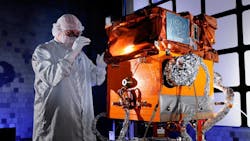Satellite Sensor Continually Tracks Solar-Earth Energy Input
As part of the Operationally Responsive Space-3 (ORS-3) mission to demonstrate launch and range improvements, the STPSat-3 satellite was successfully launched from Wallops Island this November on board a Minotaur I. It joined its predecessor, the STPSat-2, in orbit. Both satellites demonstrate the ability to rapidly access space by using standard interfaces on a standard spacecraft bus. The STPSat-3also is integrated with the Total Solar Irradiance (TSI) Calibration Transfer Experiment (TCTE)—a sensor that will provide continual calibration of the sun’s total energy input to the earth.
The TCTE sensor allows for continuous monitoring of incident sunlight—the sunlight that falls directly on a surface and is the primary energy source driving Earth’s climates. More specifically, the sensor measures TSI--the total light coming from the sun—at all wavelengths in order to monitor changes in the incident sunlight at the top of Earth’s atmosphere. This is done through the Total Solar Irradiance Monitor (TIM), which uses an ambient-temperature active cavity radiometer with estimated accuracy of 350 ppm or 0.035%. Relative changes in solar irradiance are measured to better than 10 ppm/year or 0.001%, allowing the determination of possible long-term variations in the sun’s output.
TSI was previously measured by another TIM deployed in 2003 as part of the Solar Radiation and Climate Experiment (SORCE) mission. Although it was only designed to last five years, that monitor has recorded data for more than 10. But the satellite is near the end of its battery life. Another TIM was set to launch as part of the Glory mission in 2011, but was lost due to a launch vehicle failure. The launch of the STPSat-3 was integral to avoiding a potential gap in data.
Although there were previous models to work from, one technical challenge arose in building the latest-generation TCTE: there was only so much space for the instrument on the Air Force satellite. Due to the satellite’s thermal radiator, which is required for accurate viewing in dark space, the only place for the sensor was on the sun side of the spacecraft. This, of course, created a heat-dissipation challenge. The engineers found a way to angle the radiator so it could view dark space while the TCTE views the sun.
The payloads aboard the spacecraft are designed with Ball Aerospace’s Ball Configurable Platform (BCP), which means they are compatible with the spacecraft bus. Such compatibility results in lower spacecraft non-recurring costs, shorter acquisition timelines, decreased spacecraft build costs, and increased spaceflight opportunities. The standard interfaces allow for faster integration and testing, as the bus is built in 47 days—independently of the payload. Such rapid production and deployment is expected to help in executing rapid call-up missions while automating engineering tasks that can be reduced from months to days.
STPSat-3 is managed by the U.S. Air Force Space and Missile Systems Center Space Development & Test Directorate at Kirtland Air Force Base in New Mexico as part of the Space Test Program, Standard Interface Vehicle (STP-SIV) program. More information on the satellite can be found here.
About the Author
Iliza Sokol
Associate Digital Editor
Iliza joined the Penton Media group in 2013 after graduating from the Fashion Institute of Technology with a BS in Advertising and Marketing Communications. Prior to joining the staff, she worked at NYLON Magazine and a ghostwriting firm based in New York.
